
Drosera, commonly known as the sundews, is one of the largest genera of carnivorous plants, with at least 194 species. These members of the family Droseraceae lure, capture, and digest insects using stalked mucilaginous glands covering their leaf surfaces. The insects are used to supplement the poor mineral nutrition of the soil in which the plants grow. Various species, which vary greatly in size and form, are native to every continent except Antarctica.

Drosera spatulata, the spoon-leaved sundew, is a variable, rosette-forming sundew with spoon-shaped leaves. The specific epithet is Latin for "spatula shaped," a reference to the form of the leaves. This sundew has a large range and occurs naturally throughout Southeast Asia, in southern China and Japan, Micronesia, New Guinea through to the eastern territories of Australia and Tasmania and New Zealand. Variants are often known by the localities in which they are found. The plant does not form hibernacula in winter, and is easily grown using the same methods as Drosera capensis.

Drosera regia, commonly known as the king sundew, is a carnivorous plant in the sundew genus Drosera that is endemic to a single valley in South Africa. The genus name Drosera comes from the Greek word droseros, meaning "dew-covered". The specific epithet regia is derived from the Latin for "royal", a reference to the "striking appearance" of the species. Individual leaves can reach 70 cm (28 in) in length. It has many unusual relict characteristics not found in most other Drosera species, including woody rhizomes, operculate pollen, and the lack of circinate vernation in scape growth. All of these factors, combined with molecular data from phylogenetic analysis, contribute to the evidence that D. regia possesses some of the most ancient characteristics within the genus. Some of these are shared with the related Venus flytrap (Dionaea muscipula), which suggests a close evolutionary relationship.

Drosera peltata, commonly called the shield sundew or pale sundew, is a climbing or scrambling perennial tuberous species in the carnivorous plant genus Drosera. Among the tuberous sundews, D. peltata has the largest distribution, which includes eastern and western Australia, New Zealand, India, and most of Southeast Asia including the Philippines. The specific epithet is Latin for "shield shaped", a reference to the shape of the cauline leaves. It is either a single extremely variable species, or a complex of several closely related species of uncertain taxonomic boundaries. In Australia at least four forms have had or still have specific taxonomic recognition: Drosera peltata subsp. peltata, D. peltata subsp. auriculata, D. foliosa and D. gracilis.

Drosera adelae, commonly known as the lance-leaved sundew, is a carnivorous plant in the genus Drosera that is endemic to Queensland, Australia.
The genus Drosera was divided in 1994 by Seine & Barthlott into three subgenera and 11 sections on the basis of morphological characteristics.

Drosera binata, commonly known as the forked sundew or fork-leaved sundew, is a large, perennial sundew native to Australia and New Zealand. The specific epithet is Latin for "having pairs" - a reference to the leaves, which are dichotomously divided or forked.
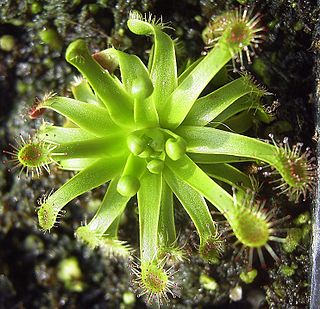
Drosera stenopetala is an insectivorous, rosette-forming perennial sub-alpine or alpine herb. The specific epithet means "with narrow petals", which is somewhat misleading given that the petals of this plant are fairly wide. A species of sundew, it is unique within its genus in being endemic to New Zealand. It is one of New Zealand's two alpine species of Drosera, the other being Drosera arcturi. Characteristic features include involute petioles and upright leaves. Its range extends from the Ruahine and Tararua Ranges in the north down the Southern Alps to Stewart Island. It is also found on the Auckland Islands and Campbell Island.
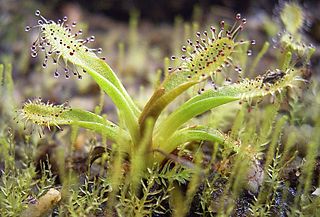
Drosera arcturi is a perennial, insectivorous species of sub-alpine or alpine herb native to Australia and New Zealand. It is one of New Zealand's two alpine species of sundew, the other being Drosera stenopetala. The specific epithet, which translates as "of Arthur" from Latin, is a reference to Mount Arthur, in north-eastern Tasmania, the type locality of the species.

Drosera bicolor is an erect perennial tuberous species in the genus Drosera that is endemic to Western Australia. It produces a basal rosette of leaves similar to that of D. peltata and the stem grows to 11 cm (4 in) high. Its white flowers that have a red spot near the petal base emerge from September to October. D. bicolor grows in deep silica sand on heathland along the upper Phillips River and south-east of Lake King.

Drosera gigantea, the giant sundew, is an erect perennial tuberous species in the carnivorous plant genus Drosera that is endemic to Western Australia. It grows in sandy soils at the margins of swamps and near granite outcrops along the Western Australian coast from Albany north to just south of Geraldton. D. gigantea produces small shield-shaped leaves along many lateral branches that look like a small tree. Individual plants can grow up to 0.2–1 m (0.7–3.3 ft) tall. Because of its tall, tree-like form, it is considered one of the largest Drosera species. It is also easily cultivated and enjoys damp, humid conditions often provided in greenhouses. White flowers emerge from August to November. The red tubers of this species can grow to be 3.8 cm (1.5 in) in diameter and may be a metre below ground.
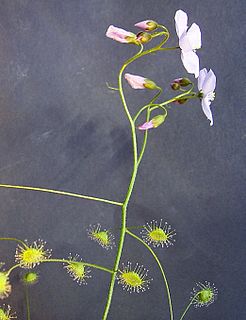
Drosera macrantha, the bridal rainbow, is a scrambling or climbing perennial tuberous species in the carnivorous plant genus Drosera that is endemic to Western Australia. It grows in a variety of habitats, including winter-wet depressions in sandy, loamy, laterite, or quartzite soils. D. macrantha produces small, cup-shaped carnivorous leaves along a long stem that can be 0.16–1.5 m (0.5–4.9 ft) high as it climbs. Its 1 in (2.5 cm) white or pink flowers emerge from June to November, blooming earlier in the more northern range.
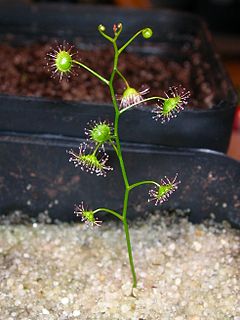
Drosera menziesii, the pink rainbow, is an erect or scrambling perennial tuberous species in the carnivorous plant genus Drosera. It is endemic to Western Australia and grows in a variety of habitats, including winter-wet depressions, swamps, and granite outcrops in clay or peat sand soils or loam. D. menziesii produces small, circular carnivorous leaves along an undulating erect stem that can be .05–1.1 m (0.2–3.6 ft) high. Its pink flowers emerge from July to November.
Drosera sulphurea, the sulphur-flowered sundew, is a scrambling perennial tuberous species in the carnivorous plant genus Drosera. It is endemic to Western Australia and is found in coastal areas in sandy loam, often among Cephalotus. D. sulphurea produces small, shield-shaped carnivorous leaves along stems that can be 40–60 cm (16–24 in) high. Yellow flowers bloom in September.

Drosera glanduligera, the pimpernel sundew, is a rosetted annual species in the carnivorous plant genus Drosera that is endemic to Australia. It is 2.5–6 cm (1–2 in) tall and grows in most soil conditions. It produces orange flowers from August to November. It was originally described in 1844 by Johann Georg Christian Lehmann. It is the sole species in the subgenus Coelophylla, which Jan Schlauer elevated from section rank in 1996; it was originally described by Jules Émile Planchon in 1848.
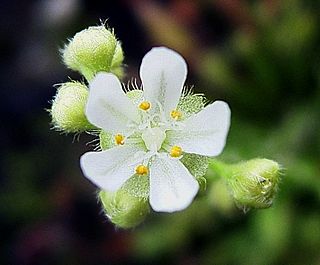
Drosera dilatato-petiolaris is a carnivorous plant in the genus Drosera and is endemic to Australia, being found in both Western Australia and the Northern Territory. Its leaves are arranged in a rosette and commonly produces plantlets, eventually forming large clumps that can be over 1 ft (0.3 m) across. Green petioles emerging from the center of the rosette are typically 3–5 mm wide, but can vary. Red carnivorous leaves at the end of the petioles are small and round, with most resting on the soil surface. Inflorescences are 18 cm (7 in) long with white flowers being produced from April to May. It has a diploid chromosome number of 2n = 12.
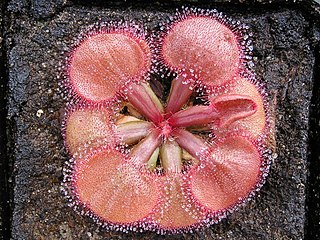
Drosera falconeri is a carnivorous plant in the genus Drosera. It is endemic to the Northern Territory of Australia.

Australia has one of the world's richest carnivorous plant floras, with around 187 recognised species from 6 genera.
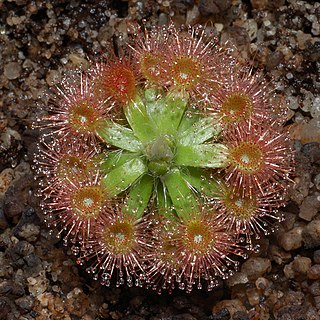
Drosera pulchella, a type of pygmy sundew , is a species of carnivorous plant native to southwestern Australia. As their common name suggests, they are a small species that usually 15 to 20 millimeters wide. They typically grow in clusters that completely cover an area like a patch of moss. The namesake sticky dew at the ends of their leaves is designed to trap insects so that the plants can absorb nutrients as the insect decomposes.

Drosera hookeri, the grassland sundew is an shortly erect perennial tuberous species in the carnivorous plant genus Drosera. Drosera hookeri is found in south-eastern Australia. Although the holotype was collected in Tasmania, its distribution also includes Victoria, New South Wales and South Australia. This species has a complex taxonomic history, and its specific epithet acknowledges the original recognition of the taxon by Joseph Dalton Hooker. Hooker originally called his species Drosera foliosa Hook.f. ex Planch. in 1848, a name that was illegitimate as it had previously been used to describe a different species. The nomenclature of D. hookeri was later clarified and the taxonomic concept significantly broadened to include most of the south-eastern Australian and New Zealand forms of the species complex that includes Drosera peltata.


















